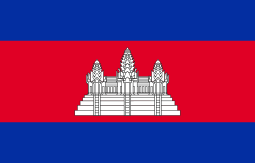Pnong people
The Pnong (alternatively Phnong, Punong, or Bunong, Khmer: ជនជាតិព្នង choncheate pnong) are an indigenous Cambodian minority ethnic group. They are found primarily in Mondulkiri province of Cambodia. The Pnong is the largest indigenous highland ethnic group in Cambodia. They have their own language called Pnong, which belongs to Bahnaric branch of Austroasiatic languages. The majority of Pnong people are animists, but a minority of them follows Roman Catholicism and Theravada Buddhism. The Pnongs are considered as Khmer Loeu or Montagnard, which is the collective name given to the various indigenous ethnic groups residing in the highlands of Cambodia.
| Total population | |
|---|---|
| 37,500 [1] | |
| Regions with significant populations | |
| Mondulkiri, | |
| Languages | |
| Pnong | |
| Religion | |
| Animist (majority), Roman Catholic, Theravada Buddhism | |
| Related ethnic groups | |
| Khmer Loeu, Khmers |
Language
Pnong language (sometimes spelled 'Mnong') is the native language of the Pnong people. It is a member of Bahnaric branch of Austroasiatic languages and is distantly related to Khmer and other Khmer Loeu languages (exclude Jarai and Rade which speaks an Austronesian language closely related to Cham). There are several dialects of Pnong, some even recognised as a distinct language by linguists, most Pnong dialects are spoken in neighbouring Vietnam, except for Kraol which is spoken within Cambodia.
Culture
The Pnong practice a very diverse, dynamic, unstructured and often secretive traditional medicine. Originally tied to the large biodiversity of their forest environment, the wars of the 1970s had a significant impact on the Pnong culture and knowledge of traditional medicine, when everybody relocated to either Vietnam or the Cambodian Koh Niek district. New plants and practices were acquired by the Pnong in these new locations, but upon returning in the 1980s and 1990s, knowledge and use of plants native to their homelands had been forgotten by many. Adequate conventional biomedicine and healthcare can be difficult or impossible to obtain by the locals in the countryside of Cambodia - in particular during the rainy season - and it is therefore official policy of the Cambodian government (backed by the WHO) to support the practice of traditional medicines. Research shows that, as of 2011, 95% of the inhabitants in two Pnong villages still regularly use medicinal plants. It is hoped that the Pnong culture of traditional medicine can help to build respect for the environment and halt the deforestation and habitat loss of Cambodia on a local level.[2]
Pnong in the media
A Pnong woman, thought to be Rochom P'ngieng, was discovered after presumably spending 19 years alone in the jungle.[3]
Other works about the Pnong include "Living on the margins", the publications of Nomad RSI, the documentary film Last of the Elephant Men, and the works of Frédéric Bourdier.
See also
References
- 2008 Cambodian census
- Savajol; et al. (2011). "Traditional Therapeutic Knowledge of the North-eastern Cambodia Healers, their practices and medicinal plants". Nomad Recherche et Soutien International. Cite journal requires
|journal=(help) - "'Half-Animal' Woman Is Discovered After Spending 19 Years Alone in Cambodian Jungle", Fox News, January 19, 2007.
